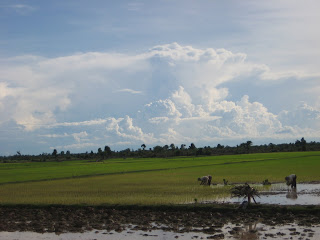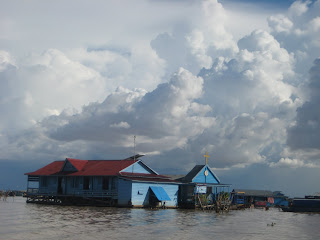The Green Gecko Project [
facebook - become a fan!] is an incredible organization run by an incredible woman. Tania Palmer, an Australian woman, read an article about kids begging on the streets of Cambodia and booked the next flight there. After meeting the kids on that trip, she returned to Australia just long enough to pack up her stuff and head back to Siem Reap, Cambodia. The project went from feeding a few of the kids to paying a school to let the kids use a room to learn English to renting a separate building to leasing a whole plot of land and building buildings where the kids could live, learn, and play.
Although the place is sometimes called an orphanage, most of the kids actually have parents - but those parents send them out with their baby siblings [to evoke more sympathy] to beg on the streets. They don't go to school, and they of course don't get to keep any of the money they make.
Now, however, just under 70 kids of all ages live at Green Gecko [and they all call Tania and her Cambodian husband Rem "Mom and Dad"]. They get plenty of food and clean clothes. They go to an accredited Cambodian school part of the day and learn English, computer skills, and more from volunteer teachers for another part of the day. Some of the kids will be going to school until
their late 20s because of their late start, but one of the Gecko kids is already on his way to college, and the organization is currently raising money to pay his way.
Green Gecko doesn't care just about the kids themselves. When they take in a kid, the rest of their family has to promise to stay off the streets, too. Green Gecko helps them stick to their promise by giving them rice each week and helping them start small businesses like book carts.
The other day I started talking to a barista who really wanted to go to Cambodia, and she said a friend of hers had gone and volunteered at an orphanage but had to leave because conditions were so bad there. Green Gecko is nothing like those places. It's clean, bright, and friendly. They have limited visiting hours so that the kids feel undisturbed and safe in their home. As Tania said, be wary of any organization that lets you visit at any time, that pulls kids out of class to perform for visitors, etc. They don't really care about the kids.
Green Gecko cares about the kids. If you have time or money or can just spread the love somehow, go to their website, read the stories, tell your friends, buy something from the
gift shop [I got the cookbook and am puuuumped to try my hand at cooking Cambodian food], donate something on the
wish list, eat at
Green Star while you're in Siem Reap to see Angkor Wat,
volunteer at Green Gecko for a few months...

The kids are split up into groups with different colors and animals; on the sides are awards for being a good helper, speaking a lot of English, etc.

They try to be as self-sufficient as possible - they have their own rice paddy that the kids help plant and harvest. Along the paddy are the huts where the different groups eat together. The kids also help with cooking, cleaning, etc. - but again, in a fair way that teaches them responsibility without taking too much time away from learning and playing.

And they use solar power!

English class.

A brother and sister showed me around [at least one of their younger siblings is in the program, too] - their English was great, and they seemed genuinely enthusiastic and happy about being Geckos.

The library.

The girl in the black-and-white picture that Tania is pointing at is the girl in real life that Tania is pointing at with her other hand, back when she had to beg with her baby sibling in arm.

It's very kid-friendly.

With some of the TAB people and Tania, an amazing woman running an amazing organization that needs - and absolutely deserves - any support you incredible people can give it.





















































